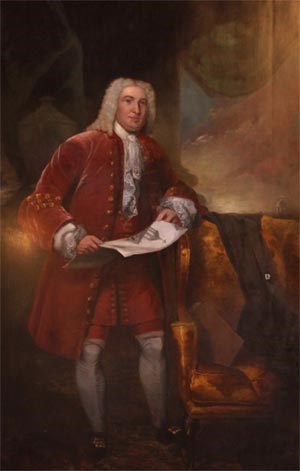Peter Faneuil’s Disability and What It Might Mean
In my recent discussion of Peter Faneuil and the meeting hall still named after him, I referred to him as disabled. That produced some questions. So here’s more on what Faneuil’s contemporaries wrote about his body.
On 3 Mar 1743, Benjamin Walker put in his journal:
I couldn’t find the term “hip short” anywhere else, but it must be the Boston spelling of the eighteenth-century term “hipshot,” defined in different dictionaries as:
On 3 Mar 1743, Benjamin Walker put in his journal:
Peter Faneuil Esqr, between 2 & 3 o’clock in ye afternoon dyed of a dropsical complyca[tion], he was a fat, squat, Lame, hip short, went with high heeled shoe (In my opinion a great loss too This Town, aged 42, 8m.) & I think by what I have heard has done more charitable deeds than any man yt, ever liv’d in this Town & for whom I am very sorry.A week later, William Nadir wrote in his almanac:
Thursday 10 [March], buried Peter Faneuil, Esqr., in 43th. year of age, a fatt, corpulent, brown, squat man, hip short, lame from childhood, a very large funeral went round ye Town house; gave no gloves at ye funeral, but sent ye gloves on ye II day, his Cofin cover with black velvet, & plated with yellow plates.These quotations appear in Abram English Brown’s Faneuil Hall and Faneuil Hall Market, or, Peter Faneuil and His Gift, published in 1900. [I took it upon myself to edit “gave us gloves” to “gave no gloves” because that makes more sense in context.]
I couldn’t find the term “hip short” anywhere else, but it must be the Boston spelling of the eighteenth-century term “hipshot,” defined in different dictionaries as:
- “is said of a Horse, when he had a wrung or sprain’d his Haunch or Hip, so as to relax the Ligaments that keep the Bone in its due Place.”
- “when the hip bone of a horse is moved out of its right place.”
- “Sprained or dislocated in the hip.”
Thus, putting together the two diary entries (and assuming those men knew what they were writing about), Peter Faneuil was born with one leg shorter than the other. His family was wealthy enough to have shoes made for him with a higher heel for the shorter leg, and for him to go into an office job rather than one that required physical labor.
Brown and other nineteenth-century authors suggested that Faneuil remained unmarried into his forties because he was “lame,” as well as squat and swarthy (an interpretation of “brown”). There’s also a story that his uncle Andrew Faneuil insisted that his two nephews and heirs remain unmarried. Peter’s brother Benjamin Faneuil definitely married around 1730, and Uncle Andrew definitely left Benjamin all of five shillings in his will. But that story didn’t appear in print until a century and a half after Peter Faneuil’s death as authors tried to arrange the known facts into a meaningful narrative.
It’s quite possible that Peter Faneuil didn’t marry because he just wasn’t interested in marrying. His uncle died in 1738, and he quickly started spending money on himself (wine, chariot, latest London cookbook) and his community (the market building, unspecified other charitable giving). At that point he was one of the richest men in North America. But he was still a bachelor five years later when he died.


No comments:
Post a Comment